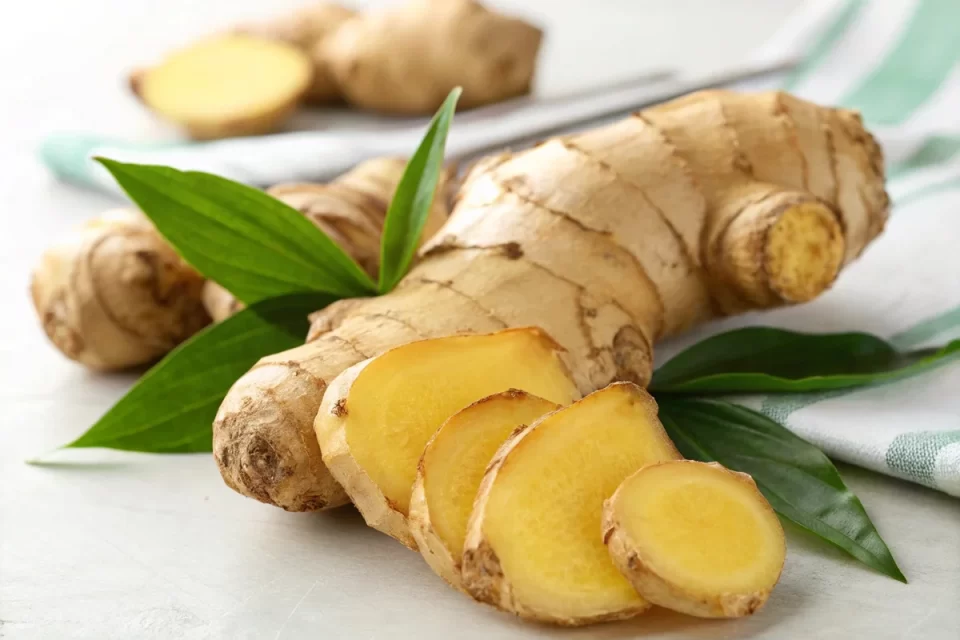inger (Zingiber officinale) is a flowering plant native to Southeast Asia, with a history of use dating back over 5,000 years. It was first cultivated in ancient China and India, where it held significant value in culinary and medicinal practices. Referenced in ancient texts like the Indian Ayurveda and Chinese Confucian writings, ginger was prized for its therapeutic properties. By the 1st century AD, it spread through trade routes to the Middle East, Europe, and Africa. During the Middle Ages, ginger became a costly commodity in Europe, valued for both its flavor and purported health benefits. Today, it is grown in tropical regions globally, with major producers including India, Nigeria, and China.
Properties
Ginger is a rhizome, commonly referred to as a root, with a pungent, spicy flavor and aromatic scent. Its key active compounds include gingerols, shogaols, and paradols, which contribute to its pharmacological effects. These compounds are responsible for ginger’s anti-inflammatory, antioxidant, and antimicrobial properties. The rhizome is typically used fresh, dried, powdered, or as an oil or juice, and is incorporated into foods, beverages, and supplements.
Nutritional Value
Ginger is low in calories and provides small amounts of essential nutrients. Per 100 grams of fresh ginger root, the approximate nutritional content is:
- Calories: 80 kcal
- Water: 79 g
- Carbohydrates: 17.8 g
- Dietary Fiber: 2 g
- Protein: 1.8 g
- Fat: 0.8 g
- Vitamins: Small amounts of vitamin C (5 mg), vitamin B6 (0.2 mg), and folate (11 µg)
- Minerals: Potassium (415 mg), magnesium (43 mg), and manganese (0.2 mg)
Dried or powdered ginger has a more concentrated nutrient profile but is typically consumed in smaller quantities.
Health Benefits
Ginger has been studied for various health benefits, primarily due to its bioactive compounds:
- Digestive Health: Ginger is widely recognized for alleviating nausea and vomiting, including motion sickness, morning sickness during pregnancy, and chemotherapy-induced nausea. It may stimulate saliva production and bile secretion, aiding digestion.
- Anti-Inflammatory Effects: Gingerols and shogaols inhibit pro-inflammatory cytokines, potentially reducing inflammation in conditions like osteoarthritis or rheumatoid arthritis.
- Antioxidant Properties: Ginger’s antioxidants help combat oxidative stress, which may lower the risk of chronic diseases such as heart disease and cancer.
- Blood Sugar and Lipid Regulation: Some studies suggest ginger may improve insulin sensitivity and reduce blood lipid levels, supporting metabolic health.
- Pain Relief: Ginger may reduce muscle pain and soreness, particularly post-exercise, and alleviate menstrual pain.
- Immune Support: Its antimicrobial properties may help fight infections, including oral and respiratory pathogens.
Other Tips
- Culinary Use: Fresh ginger can be grated into stir-fries, soups, or teas. Dried ginger is common in baking and spice blends. Store fresh ginger in a cool, dry place or refrigerate for up to three weeks.
- Dosage: Typical doses range from 0.5–3 grams of ginger daily (fresh, dried, or supplement form). Excessive consumption may cause heartburn or digestive discomfort.
- Precautions: Ginger may interact with blood-thinning medications (e.g., warfarin) due to its anticoagulant effects. Consult a healthcare provider if pregnant, breastfeeding, or on medication.
- Preparation: To make ginger tea, steep 1–2 teaspoons of grated fresh ginger in hot water for 5–10 minutes. Add honey or lemon for flavor, if desired.
Scientific Evidence
Ginger’s health benefits are supported by a growing body of research, though some areas require further study:
- Nausea and Vomiting: A 2014 meta-analysis in Nutrition Journal found ginger effective for pregnancy-related nausea and chemotherapy-induced nausea, with doses of 1–2 grams daily showing significant results.
- Anti-Inflammatory Effects: A 2019 study in Foods highlighted ginger’s ability to reduce inflammatory markers in osteoarthritis patients, though long-term effects need more investigation.
- Digestive Health: Research in World Journal of Gastroenterology (2015) supports ginger’s role in improving gastric motility and reducing bloating.
- Blood Sugar and Lipids: A 2015 study in Evidence-Based Complementary and Alternative Medicine reported improved fasting blood sugar and lipid profiles in type 2 diabetes patients with 2 grams of ginger daily.
- Pain Relief: A 2016 review in Pain Medicine noted ginger’s efficacy in reducing menstrual pain, comparable to nonsteroidal anti-inflammatory drugs in some trials. Limitations include small sample sizes in some studies and variability in ginger preparations (e.g., fresh vs. extract). High-quality, large-scale trials are needed to confirm long-term benefits and optimal dosages.

